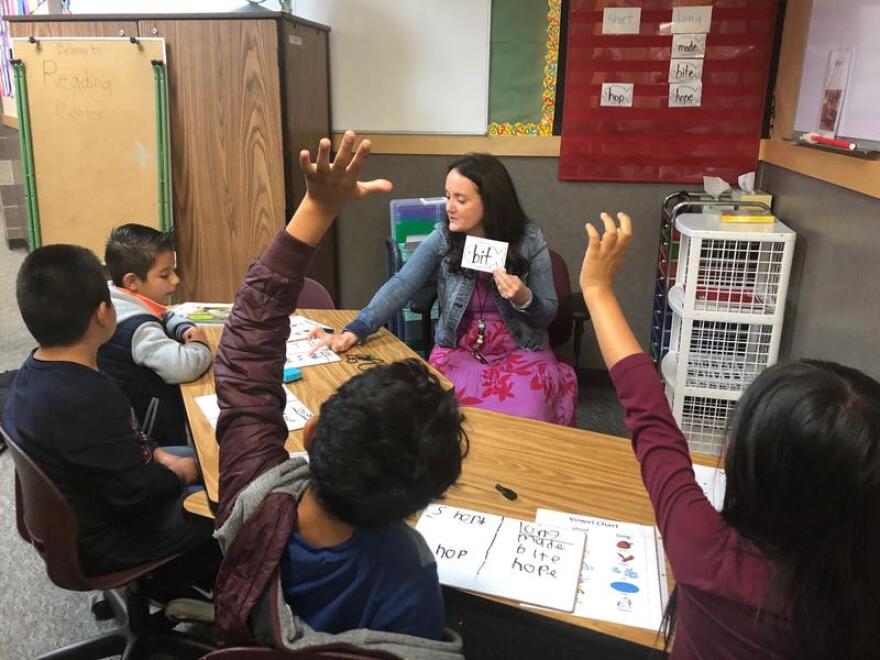It's more than two years until a law goes into effect requiring Washington elementary schools to screen students for possible signs of dyslexia. That's a reading disability that affects a lot of people — some estimates put the number as high as 1 in 5.
But some teachers already are taking time out of their summer vacation to learn methods for teaching kids with dyslexia how to read, including four teachers from a school in the Highline district who are heading to a training this week.
The teachers work at Hazel Valley Elementary in Burien, a high-poverty school with test scores below the state average. Less than half of students score at grade level in English language arts.
As a literacy specialist, Brittany Beaumont is working to help more children catch up.
On a morning in June before summer vacation, Beaumont worked with four second-graders who have been struggling with reading. She guided them in practicing how to sound out words, drilling long and short vowel sounds and the concept of the “silent e.”
Learning the sounds that letters make and how to break words up into bite-size chunks is called phonics. Decoding words can be hard for kids with dyslexia, but it's a fundamental skill. If you don't know how to decode, it's tough to read multisyllabic words. And learning that is not something our brains do naturally, unlike learning to talk.
Beaumont and three of her colleagues will take part in a training this week about the so-called Orton-Gillingham method, which teaches phonics using multi-sensory approaches. The training is offered by the Institute for Multi-Sensory Education.
Beaumont has observed colleagues use the method, which incorporates the sense of touch by, for example, having kids trace letters in sand or use modeling clay.
“Those things are all helping our students really make those connections between the sounds they can hear in words and the print they see in printed words,” she said.
This method of teaching reading has been shown to help not just kids with dyslexia, but all kids.
And yet, the pendulum in the education world has swung back and forth between emphasizing phonics and writing it off as rote and boring. Two influential podcasts from American Public Media have exposed how phonics got put on the back burner starting in the early 1990s, even though science has shown it's important for kids to get explicit instruction in translating the sounds we hear in speech into letters on the page.
Now educators like Beaumont are seeking to augment their skills to better serve students with dyslexia, who can fall through the cracks if they don't get the proper instruction.
“With it being such a high percentage of students, we can’t just think of this being a special education issue,” she said. “Chances are these students are in all of our classrooms who need this level of support.”

And it's not just these teachers from Hazel Valley Elementary seeking out this kind of multi-sensory literacy training.
“We’re absolutely seeing an uptick in educators being interested in it,” said Aira Jackson, English language arts and literacy director in the state superintendent's office. “I just had a superintendent email me about this.”
The idea that educators are seeking out this knowledge is welcome news to Bonnie Meyer, a longtime educator and board director of the Washington branch of the International Dyslexia Association.
Meyer trains teachers in a multi-sensory literacy method called Slingerland, and is dean of faculty for Slingerland Institute for Literacy, which is based in Bellevue.
“If all our kindergarten, first- and second-grade teachers had structured literacy like Slingerland or Orton-Gillingham, we would see far fewer kids that need help in the third or fourth grade and that would make a huge cost savings in our special education program, too,” Meyer said.
At Hazel Valley Elementary, Beaumont is eager to add instructional tools she can use with students.
“With the recent legislation around dyslexia screening in Washington, this really seemed like a time where this would be pivotal for me to learn this,” she said.
Once she does, Beaumont said she plans to share what she's learned with other teachers to help more kids become good readers.







